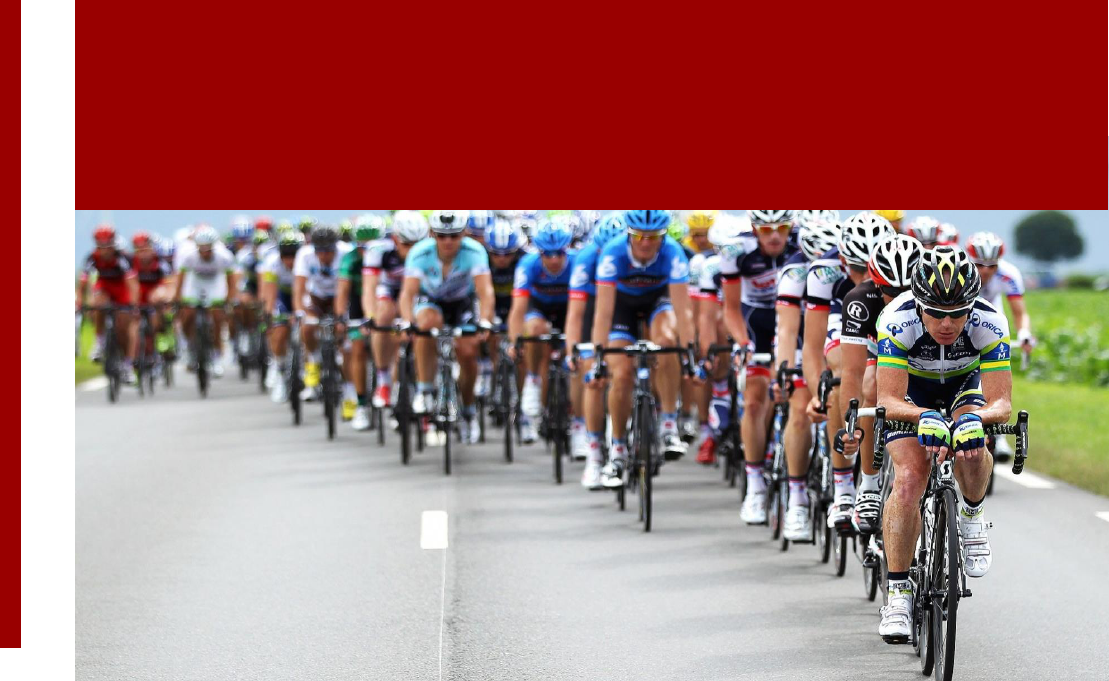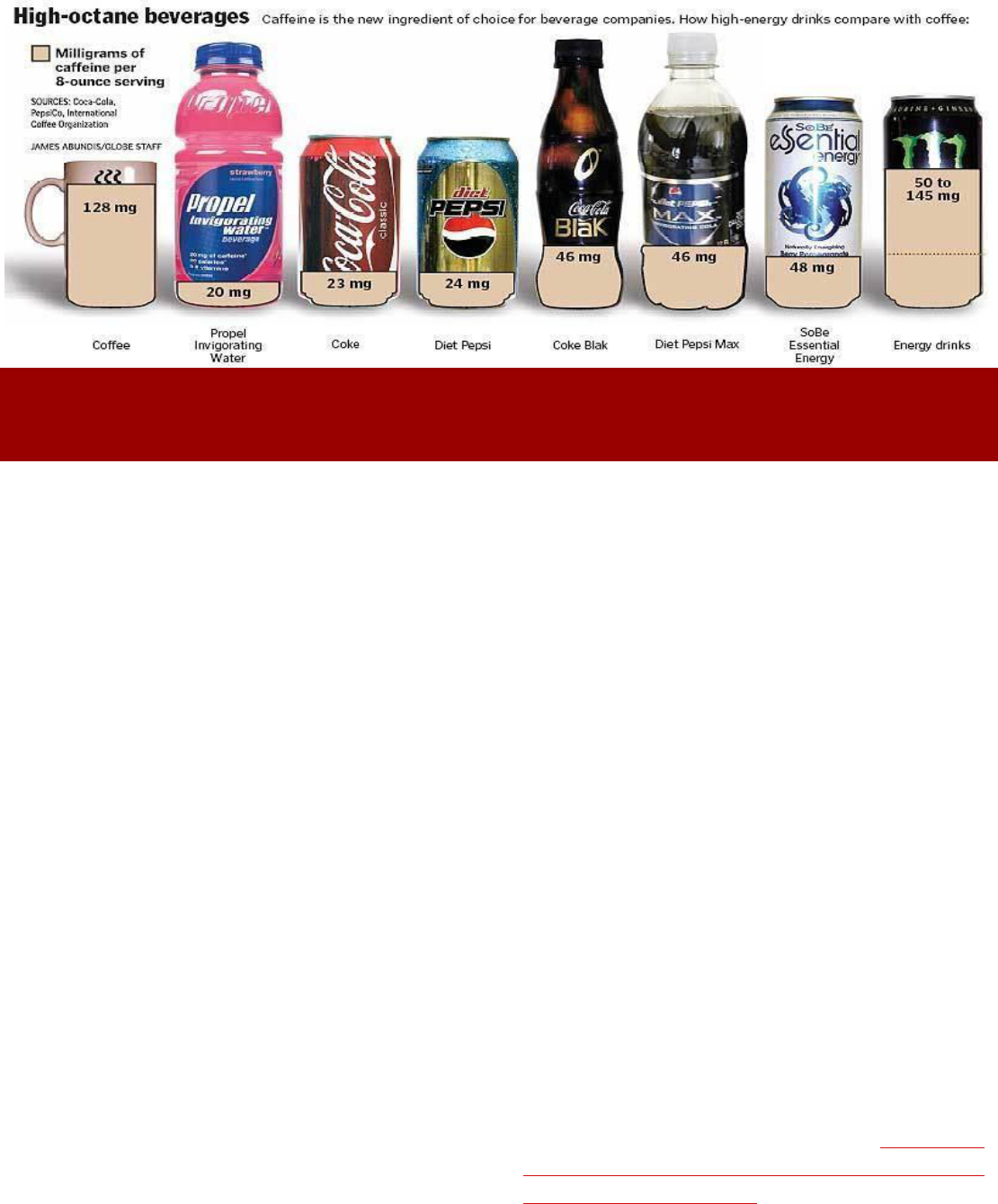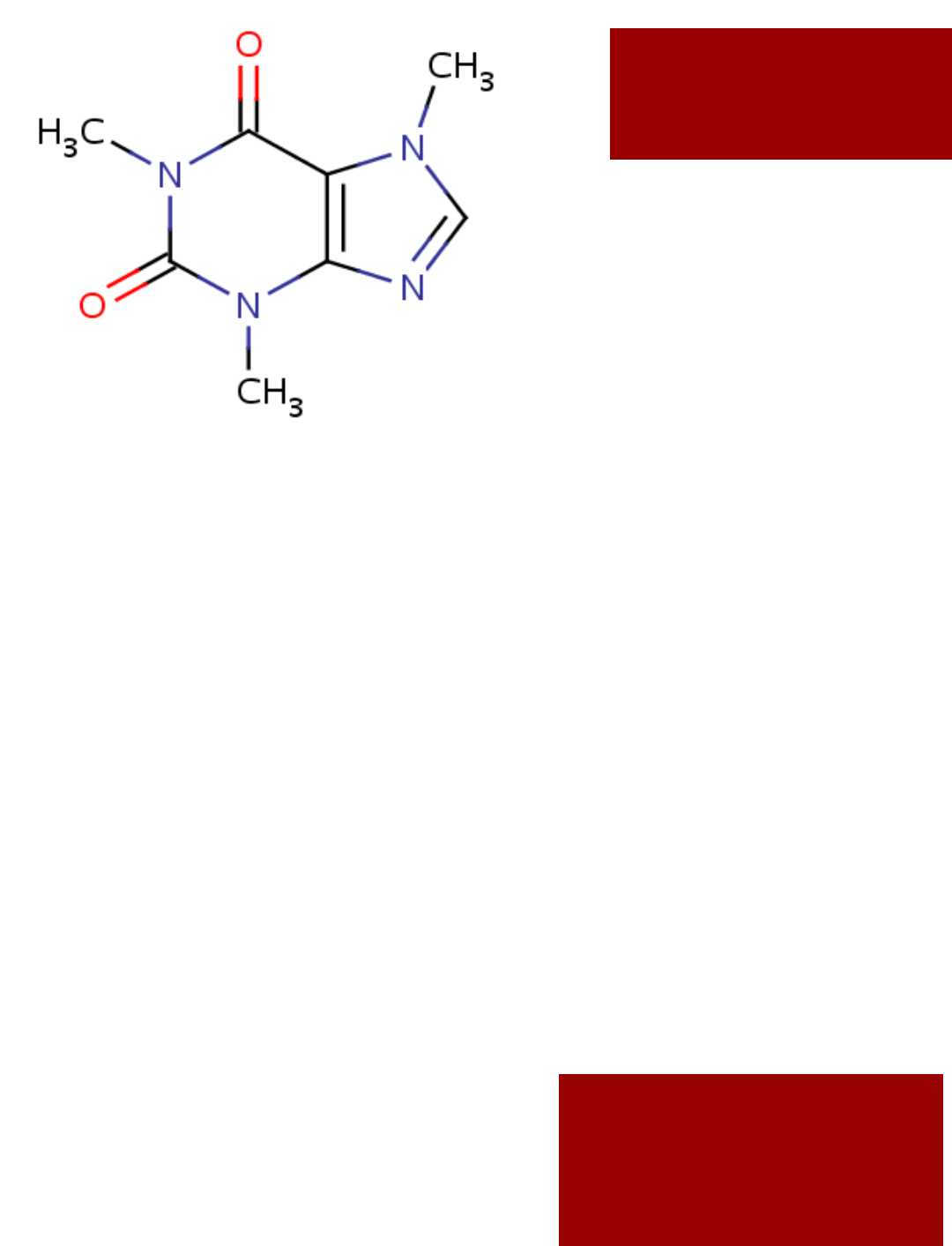
The Ergogenic Effects of Caffeine
During Sport and Exercise
BY ZACH MALINOWSKI
There is no question that caffeine fuels the lives of countless people all around the world. More
unbeknown, caffeine is used to fuel sport and exercise as well. Documentation of this goes back a
long time but has become increasingly popular only in recent times. Most often, caffeine is used to
help fuel endurance sports like cycling and running but have also been used to stimulate
performance in team-sports. Cycling usually involves riders competing in races of varying lengths
from shorter sprint-style races to other, longer races, consisting of riding over 100 miles at a time.
Running events are usually performed in a similar fashion but over lesser distances. Popular distances
are 5 kilometers, 10 kilometers, half marathons (13.1 miles) and full marathons (26.2 miles). Team sports
usually consist of varying levels of activity conducted in a random stop-and-go manner. The most
popular team-sports in the United States are Football, Baseball, Basketball, Hockey, and Soccer.
However, as the controversy of performance-enhancing drugs in sports continues to rise, caffeine has
been targeted as a drug that should possibly be removed from sports. Although the International
Olympic Committee has recently lifted its ban on the drug, the NCAA currently bans the drug in their
athletes if it is found to be at levels greater than 15 µg/ml in urine testing. Research using caffeine as
the primary stimulant during exercise dates back to over 100 years ago; the general consensus is that
caffeine does act as an ergogenic aid. On the contrary, some studies have shown that when
caffeine is used in such ways, it actually provides no ergogenic effects (Bortolotti et. Al. 2014) and
(Burke 2008). The problem is that there are many factors that contribute to caffeine’s ability to act as
an ergogenic aid. Most studies have focused and tested on factors such as the method of ingestion,
personal tolerance, and type of physical activity (Bell & McLellan 2002) and (Sökmen et. Al. 2008).
There are varying opinions on the efficiency and integrity of using caffeine stimulation in different
sports and exercise but it is important to recognize that considerable research in this topic is ongoing.
Once the physiological roles and underlying factors of caffeine in the body are fully understood, then
further conclusions and recommendations can be drawn.
Introduction

2
lorem ipsum :: [Date]
“Vivamus porta
est sed est.”
Literature Review
The majority of the literature used in this
chapter focused on the use of caffeine as a
possible performance-enhancing drug during
exercise; cycling was the most prevalent form of
exercise. Less commonly, some sources did address
and test the use of caffeine during specific team-
sports. Most of the studies were conducted in a
highly controlled laboratory using populations that
typically consisted of less than 20 college to
middle-aged, white males and females. The
independent variable was typically the amount of
caffeine ingested by individual participants (3-
9mg/ kg body weight). Examples of common
dependent variables tested were perceived
exertion, time to exhaustion, heart rate, and power
output. The sources used in this paper provided
research supporting the conclusion that caffeine
works as an ergogenic aid as well as research
showing no difference in exercise performance
after caffeine consumption.
Caffeine is widely known to play a role in the
body’s central nervous system affecting mood,
alertness, tiredness, and arousal. Although there
are no certain mechanisms of exactly how
caffeine stimulates the body, one of the most
popular mechanism theories spotlights the role
caffeine plays on the adenosine receptors. Some
of the other accepted mechanisms of how
caffeine may elicit ergogenic effects during
physical activity include muscle glycogen sparing,
maintaining higher dopamine levels, and a possible
placebo effect (Graham 2001) and (Meeusen et.
Al. 2013) and (Mitsumoto et. Al. 1990).
In a 2006 study by Wiles et. Al., eight
healthy, well-trained, male cyclists were asked to
perform a max-speed sprint of one kilometer in a
controlled environment. The focus of this study was
that they were given a specific dosage of
caffeine according to body weight, one hour and
15 minutes before the one-kilometer trials. Data
values for power, maximum power, average
speed, and time were recorded. The results
showed improvements in every category for
seven of the eight cyclists during caffeinated
time-trials. These results were very similar to
another study conducted in a 2002 by Bell and
McLellan. In this study, the dependent
variable was tested to a greater degree by
the addition of time intervals between
ingestion and activity; i.e. the effects of
caffeine on exercise in a prolonged amount of
time after ingestion (1, 3, and 6 hours). The
participants were again given a concentration
of caffeine according to body mass. The study
also emphasized the possible differences in
effects in 13 typical users and eight non-users
of the drug. Bell and McLellan concluded that
caffeine provided ergogenic effects after the
one and three-hour marks in both non-users
and users, with a longer time to exhaustion in
the non-users. One interesting note in this
particular study was that both the typical users
and non-users were asked to refrain from any
caffeine consumption for 12 hours before
each trial. Several studies further
3
lorem ipsum :: [Date]
“Vivamus porta
est sed est.”
support this cessation period concept by pointing
out that tolerance, does not completely block the
drug’s effects. These studies emphasize the
reduction of caffeine rather than complete
elimination in order to avoid the effects of
withdrawal (Graham 2001) and (Satel 2006) and
(Sökmen, et. Al. 2006). Most studies involving sports
like cycling, cross country, or track & field, focus on
endurance performance under the influence of
caffeine; results tend to trend in the direction of a
performance increase. However, in another similar
study, opposing results were found. This study
included 13 healthy, male cyclists with at least two
years of competitive cycling who received weight-
based quantities of caffeine or a placebo. The
cyclists were divided into a control and
experimental group and asked to complete a 20-
kilometer timed-trial race in a controlled
environment. The results determined that there
were no noteworthy differences in performance or
perceived exertion between the two groups
(Bortolotti et. Al. 2014).
Moving now to the more specific subject of
this chapter: caffeine’s ergogenic effect on
athletic performance in team sports. Studies in this
area have been much less common with more
vague results. Few studies are able to achieve an
experimental design that is controlled enough to
produce accurate results while continuing to
simulate the random stop-and-go nature of many
team sports. In a 2006 study by Schneiker, et. Al. 10
male, moderately trained athletes were selected
from the sports of Australian Rules Football (rugby),
soccer, and hockey -- The authors of this study
spent a vast amount of time assuring that an
accurate and detailed simulation of the
intermittent sprints during each of these sports was
created -- The athletes were then blindly given
either a placebo, or a caffeinated beverage
according to body weight. Interestingly, all of the
athletes perceived nearly identical work outputs
and exertion even though those who received the
caffeinated beverage consistently performed
more work throughout each of the tests. One other
possible point of interest in this study was that post-
urinary analysis tests showed that none of the
athletes who received the stimulant tested at
levels higher than 12 µg/ml. Other sport-based
studies have fixated on how caffeine affects
the specific attributes that quality team-sport
athletes possess. A good example of this is
illustrated in a 2014 study by Jordan et. Al., in
which elite level youth soccer players were
tested according to reaction time, agility, and
sprint speed. This study had many features of
interest including the use of youth (post-
pubescent) athletes, as well as testing reaction
time for both dominant and non-dominant
sides of the body. However, at the conclusion
of the study, no significant differences for any
of the tests, except the reaction time on the
non-dominant side of the body, were found.
Compare the results of this study to another
team sport-based (basketball, rugby, and
soccer), double blind study conducted by
Paton et. Al. (2001). Athletes who ingested
caffeine in this study also saw no increases in
anaerobic attributes like short-term sprint
speed. Similar studies that do not necessarily
focus on the dynamics of sports but rather
anaerobic or short-term exercise bouts,
consistently found that there was no increase
in power or strength as well (Greer et. Al. 1998)
and (Jacobson & Edwards 1991). These studies
tested sprints and resistance training,
respectively, and actually pointed out that it is
possible that caffeine may decrease
performance in short-term exercises if used by
the novice athlete.
All of these studies have analogous
central concepts in their experiment that serve
a major role in caffeine’s physiological
stimulation as well as in this chapter. These are
typically the independent variables used in
testing; timing of ingestion, tolerance to the
drug, use of the drug as a habit, and dose of
caffeine. These variables consistently
expressed significant changes in the drugs
effects. The drugs exercise-stimulating ability
also appears dependent upon the type of

4
lorem ipsum :: [Date]
“Vivamus porta
est sed est.”
physical activity being performed. Caffeine
seemed to have the greatest influence on
endurance sports and exercises, as stimulation
was almost completely absent in anaerobic
activities. On another note, caffeine’s half-life is
around four to six hours, and peak levels are
found within the blood in blood plasma between
30 and 60 minutes from ingestion, depending on
the person (Sökmen et. Al. 2008). The studies
examined here took advantage of this by having
participants ingest the drug about an hour prior to
physical activity testing. Most commonly, caffeine
being ingested around the world is in the form of
energy drinks/sodas, coffee, and teas (Cox et. Al.
2002) and (Meeusen et. Al. 2013). The researchers
in all of these projects focused on administering
caffeine to the participants in a much more pure
and weight-specific form than what is typically
used in daily life. Caffeine in sodas and energy
drinks may stimulate day-to-day activities, but has
shown to have less of an effect in exercise and
sports. This may be due to the extra additives in
these products. However, some people blame this
on the supposed diuretic effect of coffee and
caffeine. Although, newer research suggests that
this may not be physiologically accurate (Cureton
et. Al. 2007) and (Armstrong et. Al. 2005). Some
other commonly used caffeinated products are
illustrated in Figure 1. Overall, the take away
message of this literature review could be
stated as such: Although some contrary results
continue to be produced, the studies in this
literature are a good representation of the vast
amount of research demonstrating caffeine’s
performance enhancing ability.
The Physiological
Effect of Caffeine
Figure 1. The caffeine content in various beverages. Note that the content is per beverage rather
than per serving size. Other noteworthy beverages and products that contain caffeine include tea,
chocolate, ice creams, chewing gums, various seeds, nuts, diet supplements, and diet pills.
As discussed in the literature review, the
specific mechanism as to how caffeine may
provide an ergogenic effects is not specifically
known, and generally, many different
mechanisms are accepted as possibilities
(Graham 2001). Most nutrients that are ingested
are absorbed in the small intestine. However,
since a portion of caffeine can absorb in the
stomach, its effects can be felt rather quickly.
Once caffeine reaches the blood stream it is
spread throughout the entire body; its effects
have been observed closest in the respiratory,
skeletal muscular, cardiovascular, renal, and
central nervous systems (Battram et. Al. 2008).
Caffeine increases sympathetic activity, which
elevates heart rate and constricts blood vessels,

5
lorem ipsum :: [Date]
“I believe humans
get a lot done, not
because we’re
smart, but because
we have thumbs so
we can make
coffee” –Flash Rosenberg
raising mean blood pressure. In the lungs,
caffeine is a ventilatory stimulant, increasing
bronchiole dilation and overall ventilation
(Chapman & Mickleborough 2009). Furthermore,
most of the studies trying to determine the
specific mechanism that may induce ergogenic
effects focus on caffeine’s effect in skeletal
muscle and the central nervous system.
In the central nervous system, caffeine
stimulates the release of excess serotonin in the
brain, which is sometimes known as a mood-
enhancing neurotransmitter. The excess
serotonin also increases sympathetic activity and
decreases neuronal inhibitory activity. At a
cellular level, this is observed through the
adenosine receptors. Adenosine, which is known
for quelling arousal and encouraging sleep,
binds to these receptors and slows nerve cell
activity. Caffeine counteracts this process,
blocking the adenosine receptors, therefore
speeding up cellular activity (
Sökmen et. Al
. 2008)
Caffeine has also been observed to stimulate
and maintain higher levels of dopamine in the
brain. Because of this mechanism, caffeine is
said to improve mental alertness, concentration,
and reduce symptoms of mental fatigue
(Meeusen et. Al. 2013).
Figure 2. An ordinary caffeine
molecule. Blocking adenosine
receptors and stimulating serotonin
are two ways caffeine has been
noted to improve mood.
In skeletal muscles, it has been shown to
delay fatigue as well as creating a glycogen-
sparing effect (Cox et. Al. 2002). Technically,
this means that caffeine encourages the
muscles to burn as much of the body’s fatty
acids as possible before tapping into the much
more limited glycogen stores. Some studies
speculate that this can produce a greater
muscle contraction force as well. Moreover,
these effects are not usually observed during
anaerobic activities. The accepted theory
behind this has to do with slow and fast twitch
muscle fibers. Recall that slow twitch muscle
fibers fire more slowly making them more
efficient over time and are used for aerobic
activities; they are most active during long bike
rides, or runs. Fast twitch muscle fibers activate
anaerobically, which can generate quick
powerful bursts of speed or power but cause
fatigue rather quickly. Early research has shown
that adenosine receptors only exist in slow
twitch muscle fibers (Greer et. Al. 1998) and
Although some are accepted
more than others, there is no
proven physiological mechanism
that elicits caffeine’s ergogenic
effects.
Remember…

6
lorem ipsum :: [Date]
The exception to this of course, is the study
directed by Jordan et. Al. (2014) using elite
level youth soccer players; understand that
caffeine in youth is a separate subject in which
not much research has been devoted.
Furthermore, specific research points to the
theory that the motor unit in fast twitch muscle
fibers, the primary mechanism in muscle
contraction, is not conditioned to anaerobic
activity in the novice athlete (Mitsumoto et. Al.
1990). Thus, in a professional resistance trainer
or track & field athlete, it is possible that with
their conditioned, fast twitch motor units may
be able to benefit from caffeine’s ergogenic
effect. Nevertheless, research in professional
level athletes is greatly limited.
One factor that may not have been
specifically tested in every study but is sure to
have played a role is caffeine habituation in
the participants. If caffeine use is a habit of the
participant, a tolerance to the drug is most
likely to have developed. Tolerance has been
shown to arise in regular caffeine users in as
little as five or six days, but reducing caffeine
intake three to four days before intense
exercise or competition can allow the regular
user to attain the same ergogenic benefits as a
non-user (Graham 2001). Even though a three
to four day time frame is recommended to
allow caffeine tolerance to diminish, most
studies had participants refrain from use for
only 24 hours. Since caffeine is an addictive
drug, complete elimination of the drug can
lead to withdrawal effects – some of which
have been reported to be severe in heavy
users. Caffeine’s physical dependence has
been reported to cause things like headaches,
nausea, bad moods, and inability to focus if
use is discontinued. Such symptoms could
definitely harm performance in exercise and
sports, but moderate doses of the drug have
been observed to reverse these effects. Thus,
an extra emphasis is usually put on lowering
caffeine dose rather than total exclusion. On a
As previously stated in this chapter, there is
a long list of factors that influence caffeine’s
performance-enhancing mechanisms. These
include the quantity of caffeine ingested, the time
caffeine is ingested, the form of the caffeine
ingested, how often caffeine is used, if there is a
cessation period of use before physical activity,
the type of activity the drug is being applied to,
the skill level of the athlete involved, side effects of
the drug, and even a possible placebo effect.
Here, the major factors will be discussed in greater
detail.
The most commonly accepted mechanism
of why caffeine’s ergogenic effects only show up
in research using aerobic activities, usually relates
to the adenosine receptors in slow-twitch muscle
fibers (Greer et. Al. 1998). Since caffeine’s
ergogenic effects have been consistently
demonstrated in aerobic, endurance activities,
recall that the slow twitch muscle theory is only
used to address the lack of drug’s effects found in
most team sports, and intermittent activity
research (Jordan et. Al. 2014) and (Paton et. Al.
2001) and (Greer et Al. 1998) and (Jacobson &
Edwards 1991). However, this research is almost
always conducted using
individuals who have
simply reported to be
physically active and
volunteered for the study.
Ergogenic
Factors
(Mitsumoto et. Al. 1990). Thus, if adenosine
receptors are the primary mechanism in the
production of caffeine’s ergogenic effects, it may
explain why research showing performance
enhancement in sprints and resistance training is
almost non-existent.
7
lorem ipsum :: [Date]
other exercise hindrances; this is not
encouraged. Therefore, the best option for the
average individual seeking ergogenic effects
may be a classic cup of coffee, or more
concentrated serving of espresso. Much like
other drugs, however, caffeine has a toxic limit.
The Food and Drug Administration recognizes
an overdose of caffeine to be ingesting an
amount in excess of 10 grams. Although
ingesting this amount in a small time frame
would be nearly impossible with any
commercial products, much lower levels could
still bring about undesirable symptoms.
The efficiency of caffeine’s ergogenic
use in sports and exercise depends on a
number of intrinsic and extrinsic details. Further
studies should be conducted to provide more
detailed research on factors such as use in
professional athletes, or combining caffeine
with other dietary supplements containing
creatine or amino acids. However, evidence is
strong that the most vital factors affecting
performance enhancement are the time and
cessation period involved in use, as well as the
dosage of the drug used.
related topic, some people argue that regular
caffeine users stop gaining the stimulation of
caffeine over time and the effects felt are actually
suppression of acute withdrawal symptoms. Most
research attempting to address this theory is highly
inconsistent (Satel 2006).
Relating the arguments of withdrawal
suppression to the ergogenic effects of caffeine in
exercise and sports creates another topic of
controversy. Some people maintain the position
that the negative side effects of caffeine and
caffeine withdrawal can do more harm than
good. Most people bring up the point that
caffeine has a diuretic effect that may lead an
excessive passage of urine and dehydration. A
very interesting study by Armstrong et. Al. (2005),
concluded that there was no unusual levels of
dehydration found after 11 consecutive days of
moderate caffeine use; other studies have found
similar results (Sökmen et. Al. 2008).
Arguably, the most controlled factor in all
of the research that went into writing this chapter
was the dosage of caffeine administered to
participants during experiments. Unless the form
of caffeine was explicitly being tested, it was
almost always ingested in a more pure and
consistent pill, or powdered form according to
individual body weights. Applying caffeine
dosage per kilogram of body weight attempts to
account for participants varying basal metabolic
rates. Although caffeine in commercial products
has shown to have less of an effect on exercise
performance, some researchers believe these
effects can still be achieved if greater amounts
are consumed (Cureton et. Al. 2007). In order to
achieve an ergogenic effect from caffeine, a
dose of 3-9 mg per kilogram of body weight is
standard. Ignoring tolerance for the moment, it
would take the consumption of around five
ordinary cans of Mountain Dew, or three cans of
Red Bull in a short period of time, in order for a 70
kg individual to achieve these effects. However,
consuming large amounts of sodas and energy
drinks brings about greater health concerns and
Considerations for
Athletes
Given the number of factors and
possible mechanisms that affect caffeine’s
ability to be an ergogenic aid, there are many
considerations for athletes thinking about using
the drug.
Caffeine should be taken no less than an
hour before exercise or competition
A regular user should decrease use of
caffeine three to four days prior to
exercise or competition; be aware of the
side effects of withdrawal.
A non-user should never try caffeine for
the first time on the day of competition;
experiment in practice.

Recall that caffeine’s effects are
documented to work best in an
endurance sport rather than a
stop-and-go sport.
Take into account that the effects
of caffeine can vary from person to
person
Lastly, an important consideration
that many people tend to forget about is
the simple fact that caffeine is a
performance-enhancing drug. Thus,
under the right conditions, it can provide
an edge over a competitor whom may
choose to abstain from the drug. Some
people question the IOC’s decision to remove caffeine from the list of banned substances given the
fractional differences found in Olympic time-trial based sports. Although, it takes less than the
considered “doping” amount to provide ergogenic effects, so abuse can be difficult to identify.
Tests have shown that it takes large amounts of caffeine in an already regular user of the drug to test
higher than the NCAA limit on the drug (Schneiker et. Al. 2006). However, make sure to know the rules
on caffeine use in specific events.

9
lorem ipsum :: [Date]
References
1. Armstrong, L.E., Pumerantz, A.C., Roti, M.W., Judelson, D.A., Watson, G., Dias, J.C., So ̈kmen, B., Casa, D.J.,
Maresh, C.M., Lieberman, H., and Kellogg, M. (2005). Fluid, electrolyte and renal indices of hydration
during eleven days of controlled caffeine consumption. International Journal of Sport Nutrition and
Exercise Metabolism, 15(3), 252–265.
http://webcache.googleusercontent.com/search?q=cache:lon4fIBGKuIJ:www.researchgate.net/publication
/7628664_Fluid_electrolyte_and_renal_indices_of_hydration_during_11_days_of_controlled_caffeine_consu
mption/links/09e4150bf9c40a8468000000+&cd=2&hl=en&ct=clnk&gl=us&client=safari
2. Battram, D. S., Dela, F., Graham, T. E., Sohemy, A. E., & Thong, F. S. L. (2008). Does caffeine alter muscle
carbohydrate and fat metabolism during exercise?; coffee and caffeine: The relationship with
cancer, diabetes, and cardiovascular disease, presented at the can. soc. for clin. nutrition's annual
meeting. Applied Physiology, Nutrition, and Metabolism, 33, 1311+. Full Text
3. Bell, D. G., & McLellan, T. M. (2002). Exercise endurance 1, 3, and 6h after caffeine ingestion in caffeine
users and nonusers. Journal of Applied Physiology, 93(4), 1227-1234. Retrieved from SCOPUS
database. Full Text
4. Bortolotti, H., Altimari, L. R., Vitor-Costa, M., & Cyrino, E. S. (2014). Performance during a 20-km cycling
time-trial after caffeine ingestion. Journal of the International Society of Sports Nutrition, 11(1)
Full Text
5. Burke, L. M. (2008). Caffeine and sports performance. Applied Physiology, Nutrition and Metabolism, 33(6),
1319-1324. Retrieved from SCOPUS database. Full Text
6. Chapman, R.F., & Mickleborough, T.D. (2009). The effects of caffeine on ventilation and pulmonary function
during exercise: an often-overlooked response. The Physician and sportsmedicine, 37(4), 97-103.
Abstract
7. Cox, G. R., Desbrow, B., Montgomery, P. G., Anderson, M. E., Bruce, C. R., Macrides, T. A., et al. (2002). Effect
of different protocols of caffeine intake on metabolism and endurance performance. Journal of
Applied Physiology, 93(3), 990-999. Retrieved from SCOPUS database. Full Text
8. Cureton, K. J., Warren, G. L., Millard-Stafford, M. L., Wingo, J. E., Trilk, J., & Buyckx, M. (2007). Caffeinated
sports drink: Ergogenic effects and possible mechanisms. International Journal of Sport Nutrition
and Exercise Metabolism, 17(1), 35-55. Retrieved from SCOPUS database.
http://webcache.googleusercontent.com/search?q=cache:cfzmNs-
HE2kJ:www.researchgate.net/profile/Kirk_Cureton/publication/6369544_Caffeinated_sports_drink_ergog
enic_effects_and_possible_mechanisms/links/0c960516a8e9dafc9a000000+&cd=2&hl=en&ct=clnk&gl=us
&client=safari
9. Graham, T. E. (2001). Caffeine and exercise metabolism, endurance and performance. Sports Medicine,
31(11), 785-807. Retrieved from SCOPUS database. Full Text

10
lorem ipsum :: [Date]
10. Greer, F., McLean, C., & Graham, T.E. (1998) Caffeine, performance, and metabolism during repeated
Wingate exercise tests. Journal of Applied Physiology, 85, 1502–1508. Full Text
11. Jacobson, B.H., & Edwards, S.W. (1991) Influence of two levels of caffeine on maximal torque at selected
angular velocities. Journal of Sports Medicine and Physical Fitness, 31(2): 147–153. Abstract
12. Jordan, J. B., Korgaokar, A., Farley, R. S., Coons, J. M., & Caputo, J. L. (2014). Caffeine supplementation and
reactive agility in elite youth soccer players. Pediatric Exercise Science, 26(2), 168-176. Full Text
13. Meeusen, R., Roelands, B., & Spriet, L. L. (2013). Caffeine, exercise and the brain. Nestlé Nutrition Institute
Workshop Series, 76, 1-12. Retrieved from SCOPUS database. Full Text
14. Mitsumoto, H., Deboer, G.E., Bunge, G., Andrish, J.T., Tetzlaff, J.E., & Cruse, R.P. (1990) Fiber-type specific
caffeine sensitivities in normal human skinned muscle fibers. Anestesiology, 72(1), 50-54. Full Text
15. Paton, C. D., Hopkins W.G., & Vollebregt, L. (2001) Little effect of caffeine ingestion on repeated sprints in
team-sport athletes. Medicine & Science in Sports & Exercise, 33(5), 822-825.
http://ovidsp.tx.ovid.com/sp-
3.13.1a/ovidweb.cgi?QS2=434f4e1a73d37e8c6114a63cc85fea0981b84f1f53b15a3ad20c6ada0562041a93
afbde0427be87b647b7dfc74f470bc6c36b1fd24eae31e71ec97221e2dfb0996c895feef19d26c91dacf9acc2
78267fbfbde66877ee4d98bba264534e220d048057b6eab5f55461bdb161d050d736a77b451bd8623603b
cecdc73d1f582480e04eaa181821c23687d00f056b069cd3ee3d23fa589b8008c04e42bfeaa38080a77346f
d032d1994a1bf553adcd9724dfae09ce62b9a999eba2a65b13dee0c764ca415c5fd49ce43cfb257587d0c27
612e87ad2dcbd1f4c611321c6e95db0e349177c4af0db2aa19040a56488c5c5b67d22365f81258774e7855
309e0c9b09c6c6733aa49fe30b0e62865a4dd74ebb84a5938e300124baaefa60634bd62f3740af15d6f4c8b
04a7f856fc887a4db3c5156d589183c36d6e1fe67b5446a43f4efb315750878984810f20ccdc0d974cff2
16. Satel, S. (2006). Is caffeine addictive?—A review of the literature. American Journal of Drug & Alcohol Abuse,
32(4), 493-502. Full Text
17. Schneiker, K. T., Bishop, D., Dawson, B., & Hackett, L. P. (2006). Effects of caffeine on prolonged
intermittent-sprint ability in team-sport athletes. Medicine Science in Sports & Exercise, 38(3), 578
-585. http://ovidsp.tx.ovid.com/sp-
3.13.1a/ovidweb.cgi?WebLinkFrameset=1&S=AHKHFPMBJHDDLHFHNCLKHGDCDGBMAA00&returnUrl=o
vidweb.cgi%3f%26Full%2bText%3dL%257cS.sh.27.28%257c0%257c00005768-200603000-
00025%26S%3dAHKHFPMBJHDDLHFHNCLKHGDCDGBMAA00&directlink=http%3a%2f%2fgraphics.tx.ov
id.com%2fovftpdfs%2fFPDDNCDCHGFHJH00%2ffs046%2fovft%2flive%2fgv023%2f00005768%2f00005
768-200603000-00025.pdf&filename=Effects+of+Caffeine+on+Prolonged+Intermittent-
Sprint+Ability+in+Team-
Sport+Athletes.&pdf_key=FPDDNCDCHGFHJH00&pdf_index=/fs046/ovft/live/gv023/00005768/0000576
8-200603000-00025

11
lorem ipsum :: [Date]
18. Sökmen, B., Armstrong, L. E., Kraemer, W. J., Casa, D. J., Dias, J. C., Judelson, D. A., et al. (2008). Caffeine use
in sports: Considerations for the athlete. Journal of Strength and Conditioning Research, 22(3), 978-
986. Retrieved from SCOPUS database. Full Text
19. Wiles, J. D., Coleman, D., Tegerdine, M., & Swaine, I. L. (2006). The effects of caffeine ingestion on
performance time, speed and power during a laboratory-based 1 km cycling time-trial. Journal of
Sports Sciences, 24(11), 1165-1171. Full Text
